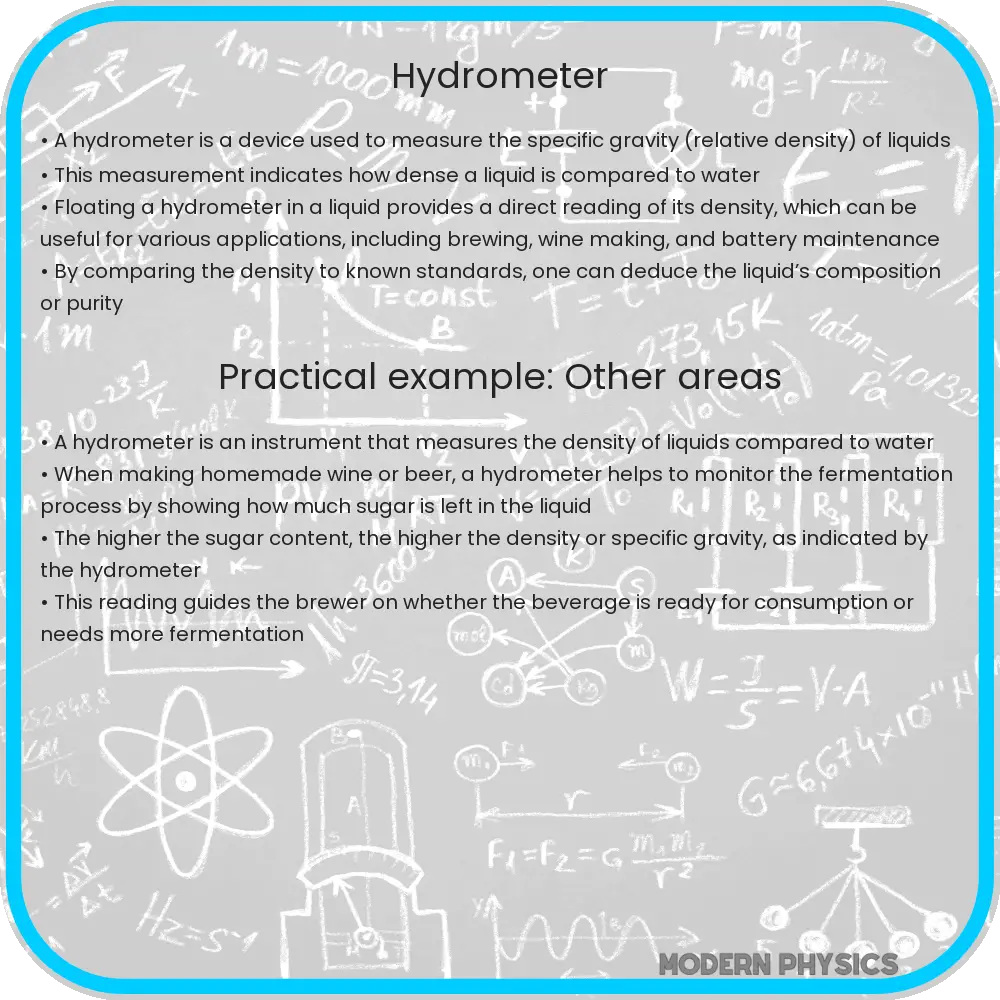Explore the use of hydrometers in measuring fluid density across fields like brewing, chemistry, and more, including their types, applications, and best practices.

Understanding Hydrometers: A Vital Tool in Measuring Fluid Density
A hydrometer is an essential instrument used in various fields like chemistry, brewing, and even winemaking, to measure the density or specific gravity of liquids. Specific gravity is the ratio of the density of a substance to the density of a reference substance; typically, water for liquids. By understanding the specific gravity, one can infer about the concentration of solutes in the solution.
Principles of Operation
The hydrometer works on the principle of buoyancy. When placed in a liquid, it floats, and the level to which it sinks depends on the density of the liquid. A less dense liquid, such as alcohol, will make the hydrometer float higher, whereas in a denser liquid, like syrup, it will sink lower. The device typically has a graduated scale, allowing the user to directly read the specific gravity.
Construction and Calibration
Hydrometers are usually made of glass and consist of a cylindrical stem and a weighted bulb at the bottom to make it float upright. The stem is marked with a scale, which could be calibrated for different measurements such as specific gravity, alcohol content, or sugar content. Calibration of the hydrometer is crucial and is generally done using water at a specific temperature.
Applications in Different Fields
- Brewing and Winemaking: In brewing and winemaking, hydrometers are used to determine the alcohol content of the beverage. By measuring the specific gravity before and after fermentation, one can calculate the alcohol content.
- Chemistry: In chemistry, it helps in determining the concentration of solutions. It is particularly useful in titrations and preparing solutions of precise concentrations.
- Quality Control: In industries, it assists in maintaining the consistency and quality of products, such as in the production of syrups, oils, and other industrial fluids.
Accuracy and Limitations
While hydrometers are highly effective, their accuracy can be influenced by various factors such as temperature, impurities in the liquid, and human error in reading. Therefore, it’s important to use them under controlled conditions and with proper techniques for reliable results.
Advanced Hydrometer Types and Innovations
Over time, the basic hydrometer has evolved into more sophisticated versions to suit various applications. Digital hydrometers, for instance, offer more precise readings and ease of use. They can directly display results without the need for manual interpretation of the scale. Another advancement is the use of portable, handheld hydrometers that provide quick and on-site measurements, invaluable in fieldwork and industrial settings.
Best Practices for Using Hydrometers
- Temperature Control: Since the density of liquids changes with temperature, it’s crucial to conduct measurements at a consistent temperature, or apply corrections based on the liquid’s temperature.
- Avoiding Parallax Error: When reading the scale, ensure the eye level is at the same level as the liquid’s surface to avoid parallax error.
- Clean and Rinse: Always clean and rinse the hydrometer before and after use to prevent contamination and ensure accurate readings.
Chemical and Physical Considerations
Understanding the chemistry and physics behind the hydrometer is important. The buoyant force acting on the hydrometer is equal to the weight of the liquid displaced by it, as per Archimedes’ principle. For chemical solutions, factors like molecular weight, solute-solvent interactions, and concentration gradients can influence readings and must be considered during analysis.
Conclusion
In summary, hydrometers are invaluable tools for measuring fluid density, with wide-ranging applications from brewing to chemical analysis. Their ease of use, coupled with advancements like digitalization, make them an essential tool in both educational and professional settings. While the principle behind hydrometers is straightforward, achieving accurate results requires understanding their limitations, proper calibration, and best practices. With these considerations in mind, hydrometers continue to be a fundamental tool in scientific and industrial work, bridging the gap between theory and practical application.
